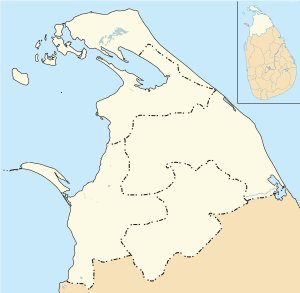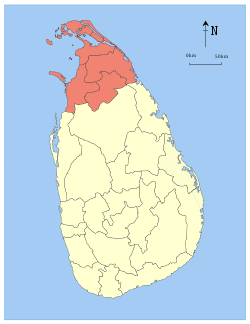Maviddapuram Kandaswamy Temple
Maviddapuram Kandaswamy Temple (Tamil: மாவிட்டபுரம் கந்தசாமி கோவில்) is a Hindu temple in Maviddapuram in northern Sri Lanka.
| Maviddapuram Kandaswamy Temple | |
|---|---|
மாவிட்டபுரம் கந்தசாமி கோவில் | |
| Religion | |
| Affiliation | Hinduism |
| District | Jaffna District |
| Deity | Murugan |
| Location | |
| Location | Maviddapuram |
| State | Northern Province |
| Country | Sri Lanka |
 Location within Northern Province | |
| Geographic coordinates | 09°48′04.00″N 80°02′06.20″E |
History
According to legend Maviddapuram has had a Hindu shrine for 5,000 years.[1] According to another legend, an 8th-century Chola[lower-alpha 1] princess Mathurapuraveeravalli,[lower-alpha 2] daughter of Tissai Ughra Cholan, the King of Madurai, was inflicted with a persistent intestinal disorder as well as facial disfigurement which made her face look like a horse.[3][4][5] She was advised by a priest/sage to bathe in the freshwater spring at Keerimalai.[3][4] After bathing in the spring Mathurapuraveeravalli's illness and disfigurement vanished.[3][4] In gratitude she renovated a Hindu shrine, located in Kovil Kadavai about two kilometers south east of the spring, into a full temple honouring the Hindu god Murugan (Skanda).[3][4][5] The King of Madurai sent sculptors, artists, building material, granite, statues, gold, silver etc. to assist with the renovation.[3] The temple's statue of Kankesan (Murugan) was brought via the port of Gayathurai which was later renamed Kankesanthurai.[6][7]
The name Maviddapuram is derived from ma (horse), vidda (removed) and puram (holy city).[3] The temple was destroyed and rebuilt several times.[1] The present day temple dates from the 17th century.[8]
Only "high" caste Hindus had been allowed to worship in the temple.[9] In 1968 several hundred "low" caste Hindus, mainly Pallar and Nalavar, staged a non-violent protest outside the temple gates but were met with violence from a group of "high" caste Hindus.[10] In June 1968 "low" caste Hindus stormed the temple.[11] They were given access to the temple following the intervention of Illankai Tamil Arasu Kachchi (ITAK, Federal Party).[12] C. Suntharalingam, who had led the "high" caste resistance to opening the temple up to the "low" castes, was prosecuted under the Prevention of Social Disabilities Act and fined Rs. 50 by the Supreme Court.[13] This act, which had been brought in as a private member's bill by ITAK in 1957, made the denial of entry into a place of worship on grounds of caste an offence.[12][13]
During the early 1990s the northern part of the Valikamam region were declared a High Security Zone (HSZ) and all the residents expelled.[14][15] The temple was inside the HSZ and as a result its priests were evicted by the military.[8][16] The temple's structure was bombed and its contents looted.[8] Following the end of the civil war the military relaxed some restrictions on entering the HSZ, allowing priests and worshipers to return to the temple.[8] The temple's 108 foot gopuram has been re-built but much of the 17th century temple was destroyed during the civil war.[8]
The temple was declared an archaeological protected monument in December 2011.[17]
Notes
- Another source states that the princess was Pandyan.[2]
- Also Maruthapuraveegavalli, Marutappiravikavalli.
References
- Dissanayake, Daya (30 November 2011). "Temple carvings in Jaffna". Daily News (Sri Lanka).
- The Rough Guide to Sri Lanka. Rough Guides.
- Yatawara, Dhaneshi Yatawara (17 August 2008). "Festival of devotional splendour". Sunday Observer (Sri Lanka).
- Wijesinghe, W. A. M. (28 November 2010). "The rich colours of Hinduism". The Nation (Sri Lanka).
- David, Kenneth (1977). "Hierarchy and Equivalence in Jaffna North Sri Lanka: Normative Codes as Mediator". In David, Kenneth (ed.). The New Wind: Changing Identities in South Asia. De Gruyter Mouton. p. 185. ISBN 90-279-7959-6.
- Yatawara, Dhaneshi (1 September 2013). "Surge of devotion reverberates the North". Sunday Observer (Sri Lanka). Archived from the original on 5 April 2016. Retrieved 26 March 2016.
- "Maviddapuram Kandaswamy Kovil". Time Out.
- Karafin, Amy (15 March 2013). "Sri Lanka, as It Heals From War". The New York Times.
- Welhengama, Gnanapala; Pillay, Nirmala (2014). The Rise of Tamil Separatism in Sri Lanka: From Communalism to Secession. Routledge. p. 211.
- Wickramasinghe, Nira (2014). Sri Lanka in the Modern Age: A History. Oxford University Press. p. 289. ISBN 978-0-415-85486-3.
- Jayaweera, Neville (23 January 2011). "Without 1956 and 1983 as triggers – would the Tamil uprising have occurred anyway?". The Island (Sri Lanka).
- Hoole, Ratnajeevan (14 July 2013). "Jaffna's Upcoming Elections: Caste Ramifications". The Sunday Leader.
- Jayaweera, Neville (16 November 2008). "The wretched of the earth". The Island (Sri Lanka).
- Jeyaraj, D. B. S. (18 January 2003). "High-stakes zones". Frontline. 20 (2).
- "Asia Report No. 220 - Sri Lanka's North II: Rebuilding under the Military" (PDF). International Crisis Group. 16 March 2012. p. 21. Archived from the original (PDF) on 14 August 2013.
- Jansz, Frederica (5 January 2003). "HSZs rock peace process". The Sunday Leader.
- "PART I : SECTION (I) — GENERAL Government Notifications" (PDF). The Gazette of the Democratic Socialist Republic of Sri Lanka. 1739: 1093. 30 December 2011. Archived from the original (PDF) on 9 April 2014. Retrieved 26 March 2016.
External links

